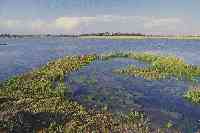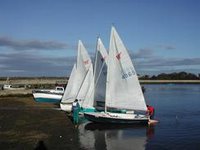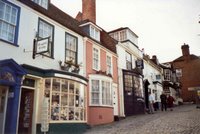Day 3: Keyhaven and Lymington (Elizabeth Goudge)
If I were to pick my top ten favourite books, there would be at least one from Elizabeth Goudge in there. I might cheat and include her trilogy about the Eliots of Damerosehay as one book. As with most of her writing these are truly heartwarming, with characters who make difficult but morally right choices and ultimately reap the benefits. All her books have a strong sense of place, drawing on memories of houses, towns and areas she has known and loved. In the Eliot trilogy - The Bird in the Tree, The Herb of Grace (US title: Pilgrim's Inn) and The Heart of the Family - that place is an old and beautiful house she calls "Damerosehay". The house that was the model for Damerosehay no longer exists, but the location does - the edge of the New Forest on the south coast of England, adjoining the salt marshes of Keyhaven. Elizabeth Goudge first visited the area as a schoolgirl and never forgot the impact it made on her. She describes it in her autobiography, The Joy of the Snow:
Somehow I was by myself at the edge of the sea, the others as non-existent as though the sea mist had swallowed them for ever. I do not know how I had managed to escape them but escaping was one of my few skills in those days. It was so still that the half-moons of water from the incoming tide moved as silently as shadows on the sand. The thinning mist half hid, half revealed the sea-marshes to my left. I was so awed that I could not move. I kept listening and watching but I could not hear anything, or see anything clearly. It was all hidden in the mist ... Keyhaven. The harbour and the old houses, the yachts at anchor and the circling gulls, the rough road through the marshes and the old cornfield that had sprung up by itself after a grain-ship had been wrecked there, Damerosehay and its garden, the oak trees and the ilex tree. It was all there with me in that moment that seemed out of time and all I knew about it was my sense of awe. I do not remember how I found the others or how they found me. For all I can remember I might be standing there still.
 I once spent a few days at nearby Milford-on-Sea, but although I already knew and loved the books I didn't realise that it was so close to the setting for Damerosehay. Rather than exploring the coast we mostly headed inland so this is new territory for me. Although Elizabeth Goudge complained that much of the area had been ruined by "modern development" (no doubt worse since her day!) these pictures suggest there is enough wild seascape left to get a feel for what it must once have been. These days it is designated a Site of Special Scientific Interest and includes a bird reserve. Maybe we will be lucky and get a misty day to add to the effect - the sort of early morning mist that clears to blue skies and fluffy clouds.
I once spent a few days at nearby Milford-on-Sea, but although I already knew and loved the books I didn't realise that it was so close to the setting for Damerosehay. Rather than exploring the coast we mostly headed inland so this is new territory for me. Although Elizabeth Goudge complained that much of the area had been ruined by "modern development" (no doubt worse since her day!) these pictures suggest there is enough wild seascape left to get a feel for what it must once have been. These days it is designated a Site of Special Scientific Interest and includes a bird reserve. Maybe we will be lucky and get a misty day to add to the effect - the sort of early morning mist that clears to blue skies and fluffy clouds.
From Keyhaven we can walk across the salt marshes to the little town of Lymington, another of Elizabeth Goudge's beloved places:
It was a little port always humming with activity about the harbour, but the streets of old houses that climbed above the harbour were, as I remember them, quiet streets. There was life in them but it did not seem to have changed much since the days when aristocratic refugees from the French Revolution made their home there.
 Although it isn't mentioned in her autobiography, it doesn't take much detective work to recognise it as the setting for one of her children's books, I Saw Three Ships. The book even has a French refugee in it, so it just has to be Lymington. If you want a gentle Christmas read aloud for a girl aged around six to ten, this one is worth searching out. Lymington itself also looks well worth a visit.
Although it isn't mentioned in her autobiography, it doesn't take much detective work to recognise it as the setting for one of her children's books, I Saw Three Ships. The book even has a French refugee in it, so it just has to be Lymington. If you want a gentle Christmas read aloud for a girl aged around six to ten, this one is worth searching out. Lymington itself also looks well worth a visit.Surely some of those pretty little shop fronts belong to tea shops or book shops. And wouldn't it be good to find a nice homely bed and breakfast for the night in one of these old streets to rest up before we set off on tomorrow's tour.






